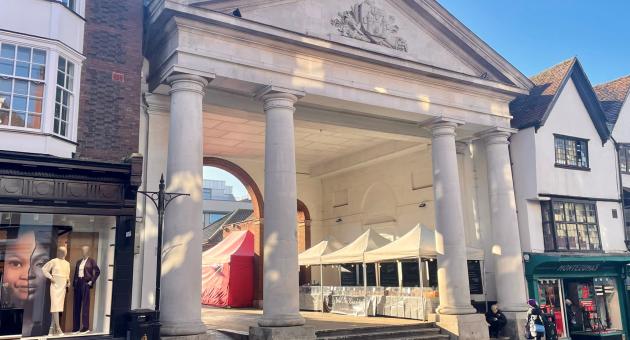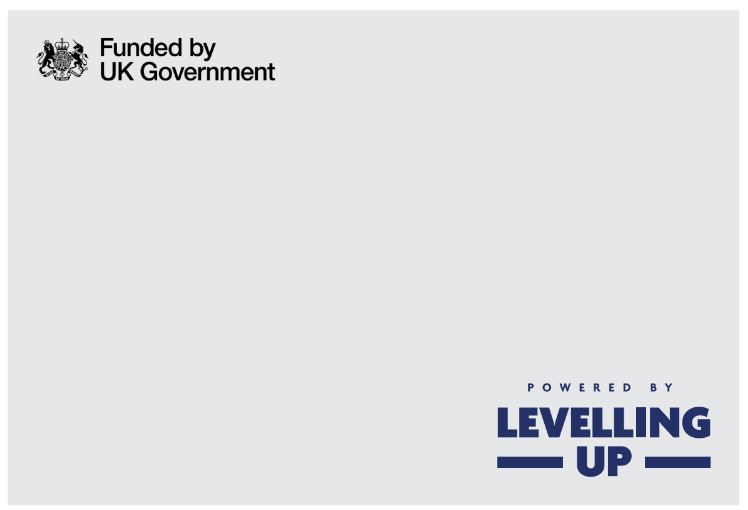Easy
Walking
Exploring Guildford

- Difficulty
- Easy
- Distance
- 2 ml
- Duration
- 1.5 hr
GU1 3AA
Enjoy this easy walk and discover some of Guildford’s special little hidden gems. This walk is funded by the UK government through the UK Shared Prosperity Fund,
Distance: 2 miles (1.5 hours)
Start: Tunsgate Arch, High Street, Guildford
Postcode: GU1 3AA
End: Guildford House, High Street, Guildford
Postcode: GU 1 3AJ
Postcode: GU1 3AA
End: Guildford House, High Street, Guildford
Postcode: GU 1 3AJ
A Guildford Guided Trail
- The walk starts under Tunsgate Arch, mid-way up the High Street. It was built in 1818 as the portico to the town’s Corn Exchange. Opposite is the Guildhall, which dates from the 14th century and was formerly a courtroom and council chamber. Mounted on the front is the impressive town clock dating from 1683. Walk up Tunsgate (where there are several cafes and eateries worth stopping at) to view the Norman castle.
- Cross over Castle Street and through the gates into the bowling green, next to the castle grounds. The pub The March Hare is a nod to the author Lewis Carroll (real name: Rev. Charles Dodgson), who had his family home nearby and wrote Alice in Wonderland.
- The Castle Grounds and bowling green were bought by Guildford Corporation in 1885. They opened in 1888, as a Victorian Pleasure Gardens to mark Queen Victoria’s Golden Jubilee, in the previous year. Follow the path around the bowling green, and then down into the lower gardens at the base of the castle keep. (It is worth walking up to the top of the castle keep to take in the views over Guildford. Check for opening times).
- At the intersection, turn left past some of the remains of the royal palace, now set amongst award winning gardens, and bare left go through the arch on the left. If you look up the road here to your left you will see the Victorian detached house called The Chestnuts, which was the family home of Lewis Carroll, which he shared with his many unmarried sisters.
- Turn left and follow the path through the Castle Gardens with splendid views of the castle keep on your left, to an iron gate on your right after 25m. Enter and follow the path. Almost immediately you will see to your right a statute of Alice through the Looking Glass, created in memory of Lewis Carroll. He wrote much of this second book about Alice here. The back of his house is just beyond the statue and it is here in Guildford that he died in 1898.
- Retrace your steps back to the arch you passed under to leave the gardens. Keep going straight ahead as the path joins a road down to another large Castle Archway. The arch was built in 1256, as the main entrance to Guildford Castle. Turn right into Quarry Street, past Guildford Museum, and down to St Mary’s Church, the only remaining building in Guildford dating from the Saxon period.
- Turn left into Mill Lane and cross over at the traffic lights.
- Turn left, then immediately right to walk past the old mill formerly used for milling corn and pumping the water supply. Walk along the alley to the left of the Yvonne Arnaud Theatre, which dates from 1965. (Café and toilets inside). Continue on path over the Wey Navigation (canal) and River Wey.
- Turn right at the car park. Walk along the river until you see the statue of Alice in Wonderland, showing Alice with her sister and the white rabbit, near The White House pub (a lovely lunch stop by the river) Continue on until you come to the Town Bridge.
- Turn right over the bridge and look up the attractive historic High Street.
- Turn immediately left after the bridge and follow the river path. Note the statue on the left of The Bargeman, which recognises the long history of trading on this river. This area was once a busy wharf and the old treadmill crane has been retained and preserved here. Go past the old crane and then look out for an underpass on your right, just before the next bridge, called Friary Passage.
- Go up Friary Passage to Friary Square. The Friary Shopping Centre to your left, takes its name from the medieval Dominican Friary that used to stand on the site. The site later became the site of the Friary Brewery. (The Friary Shopping Centre is Guildford’s main shopping hub and as well as featuring many High Street shopping brands it also contains some great food outlets - especially on the top floor. Toilets available here too).
- Turn right and walk down Friary Street to the High Street.
- Turn left up the High Street. You will pass the attractive The Angel Hotel, the last surviving Georgian coaching inn in the town. Guildford was a convenient halfway point between London and the south coast. The Angel itself dates from medieval times. It has been an Inn since 1522.
- Turn left along Angel Gate with its boutique shops and cafes.
- Turn right into North Street, where yet more interesting shops and restaurants are on offer. At the top of the hill you come to Quaker’s Acre, originally the town’s Quaker burial ground. The public toilets opposite with the clock tower was once Guildford’s first fire station, opened in 1872.
- A little further up, just past the Library, turn right into Jefferies Passage (with more interesting shops) and re-join the High Street. Directly opposite is Holy Trinity Church. This Georgian church was rebuilt in 1761 after the original spire collapsed during building alterations. Opposite the church stands Abbot’s Hospital, founded in 1619 by George Abbot, a local Guildfordian, who became Archbishop of Canterbury. Further up the High Street is a statue of George Abbot.
- Turn left on the High Street and continue on into the Upper High Street to the Royal Grammar School. It was created in 1553, when Edward VI re-endowed the school (which had been established in 1509). (There are more shops and restaurants to tempt you here).
- A little further up the High Street is the Grade I Listed, Somerset House. This building was originally built as a town house for the Duke of Somerset, who used to stay here on his way to his estate at Petworth, in West Sussex.
- Go back down the High Street to the start of the walk, visiting the Grade I Listed Guildford House, on the right as you go. This is a gallery and tourist office which is free to enter. It is a fine example of an Elizabethan town house. It was built for lawyer and Mayor of Guildford, John Childs, in 1660. It has been used as the town’s public Art Gallery since 1959. Continue down the High Street until you are back at the Tunsgate, where you started.
Local Facts:
- The Tunsgate Arch, built in the Tuscan style with four columns, was built in 1818 to house the expanding Corn market exchange. The two middle columns were moved apart in 1933 to allow cars to pass under it. The coat of arms of Guildford and that of its twin town Freiberg are set into the pavement.
- Guildford Castle is thought to have been built shortly after the 1066 invasion of England by William the Conqueror. It fell into disrepair in the 14th century. Since Victorian times it has been an attractive pleasure garden.
- St Mary’s church is the only remaining building in the town from the Saxon era.
- Internationally famous Victorian author, Lewis Carroll, whose real name was Charles Lutwidge Dodgson, rented The Chestnuts in Guildford to house his six sisters. It is here he wrote “Alice through the Looking Glass” and eventually died there in 1898.
- After World War I the local Friary Brewery generously bought the green hillside you can see from the High Street, called The Mount. It was presented to the town as a war memorial. It is now managed by Guildford Borough Council and a team of volunteers.
- Guildford Cathedral (which can be seen from Guildford Castle Keep) was designed and built by Sir Edward Maufe between 1936 and 1961 and is the seat of the Diocese of Guildford. One of only two Anglican cathedrals to be built on entirely new sites since medieval times.
- Although Guildford has a cathedral it is not a city. In 2002 and 2022 Guildford applied for city status, but has not yet been successful.
This project is funded by the UK government through the UK Shared Prosperity Fund.
The UK Shared Prosperity Fund is a central pillar of the UK government’s Levelling Up agenda and provides £2.6 billion of funding for local investment by March 2025. The Fund aims to improve pride in place and increase life chances across the UK investing in communities and place, supporting local business, and people and skills. For more information, visit UK Shared Prosperity Fund Prospectus.

Historic
